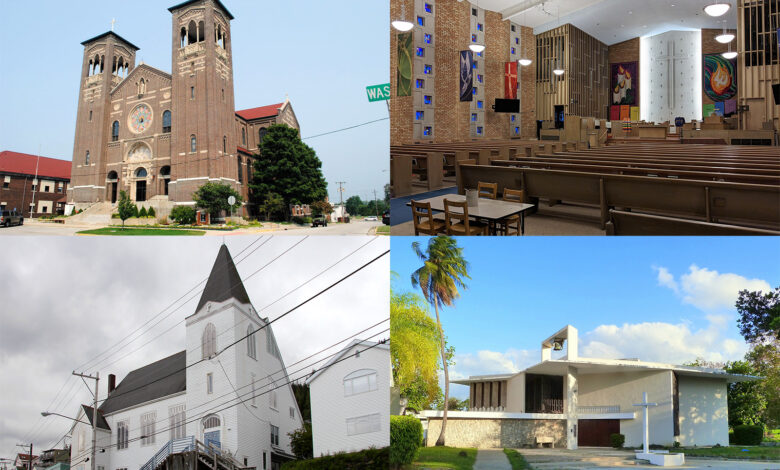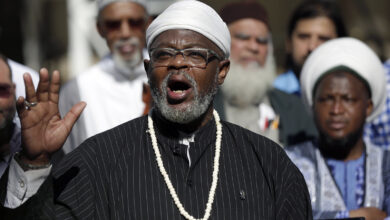National Fund for Sacred Places awards $4 million for preservation of historic houses of worship

(RNS) — Two dozen historic faith communities have received grants from The National Fund for Sacred Spaces, in collaboration with the National Trust for Historic Preservation, to be used to support critical preservation projects that will help maintain and extend the life of their houses of worship. The 2024 grants, $4 million in total, were awarded to two Reform synagogues and a diverse array of Christian churches across the U.S., including a historic Catholic sanctuary in Puerto Rico.
“Sacred places hold power to inspire awe, joy and a sense of connection, belonging and purpose,” said Carol Quillen, president and CEO of the National Trust for Historic Preservation. “The grants and technical support provided by the National Fund will ensure that these spaces serve as meaningful centers within their communities for generations.”
Since 2016, the National Fund for Sacred Places, a program of Partners for Sacred Places, has awarded more than $26 million to 138 congregations across 42 states, D.C. and Puerto Rico. In addition to the capital grants of up to $500,000, Partners for Sacred Spaces offers a range of technical support and consulting for grantees, including for fundraising and stewardship campaigns, as well as ideas for community engagement and space sharing, according to their site.
“We are proud to welcome 24 faith communities into the National Fund this year, representing diverse regions, traditions, and heritages,” said Bob Jaeger, president of Partners for Sacred Places, in a statement. “Their buildings will continue to serve as community centers, art spaces, and safe havens. We’re honored to help them continue this critical work.”
The National Fund 2024 grantees are:
- Billings First Congregational Church, UCC – Billings, Mont.
- Campbell Chapel A.M.E. Church – Bluffton, S.C.
- Central United Methodist Church – Detroit, Mich.
- Christ on Capitol Hill – St. Paul, Minn.
- Congregation Mishkan Israel – Hamden, Conn.
- Denver Community Church – Denver, Colo.
- First Congregational Church, UCC – Columbus, Ohio
- First Lutheran Church of Ketchikan, Alaska
- First Presbyterian Church – Fargo, N.D.
- First Presbyterian Church of Taos, N.M.
- Historic St. George’s United Methodist Church – Philadelphia, Pa.
- KAM Isaiah Israel– Chicago, Ill.
- Kinderhook Reformed Church – Kinderhook, N.Y.
- New Life at Calvary Church – Cleveland, Ohio
- Santuario Nacional San Martín de Porres – Bayamón, Puerto Rico
- St. James’ in the City Episcopal Church – Los Angeles, Calif.
- St. Paul’s Episcopal Church – Marquette, Mich.
- St. Stanislaus Kostka Parish – Michigan City, Ind.
- Tabernacle Baptist Church – Augusta, Ga.
- The Church of the Holy City – Wilmington, Del.
- The Falls Church Episcopal – Falls Church, Va.
- Warren Temple United Methodist Church – LaGrange, Ga.
- West Central Abbey – Spokane, Wash.
- Zion Baptist Church of Philadelphia, Pa.
Steven Jacober, director of Congregation Mishkan Israel, shared his community’s plan for the grant. “The grant will be used to replace our roof, which has been in need of attention for many years. A piecemeal approach to repairs has only exacerbated the deteriorating condition of the roof.”
Tom Worley, grant coordinator and volunteer at First Congregational Church, UCC, said the church plans to repair its rose window, front facade and the main entrance. The church was founded in 1852 as an abolitionist church and is home to Washington Gladden Social Justice Park, the first social justice park in the nation.
Rachel Hildebrandt, director of the National Fund for Sacred Places, reflected on the need for funds in historic preservation. “This year we received nearly 500 applications, up 31% from last year. The growth we’re seeing mostly is the result of word of mouth and underscores the reality that historic sacred places need external support to balance caring for their buildings and serving their communities.”
The communities were chosen due to their historical significance and their community engagement. With additional funding from the Lilly Endowment, the National Fund for Sacred Places was able to more than double its funding to the congregations, Hildebrandt said.
Source link




